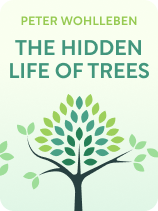

This article is an excerpt from the Shortform book guide to "The Hidden Life of Trees" by Peter Wohlleben. Shortform has the world's best summaries and analyses of books you should be reading.
Like this article? Sign up for a free trial here.
Why are forests so important to the global ecosystem? What role do forests play in regulating the climate? Why do so many species rely on forests?
We all know trees are important, but in his book The Hidden Lives of Trees, Peter Wohlleben explains just how crucial forests are to life on Earth. Trees help water move around the planet, mitigate climate change by storing carbon dioxide, provide habitats for animals and plants, and more.
Continue reading to learn why and how forests are important to life on Earth.
The Importance of Trees
While Wohlleben argues that trees are innately valuable, he also explains how they’re crucial to the survival of numerous species, including humans. In this article, we’ll highlight why forests are important in the global ecosystem and explain the sometimes unexpected ways in which humans, and other species, depend on them to survive.
1. Forests Help Control Our Climate
First of all, Wohlleben explains, forests help regulate our climate on a regional and global level.
Forests help maintain regional climates through their role in the hydrological cycle, or the way water moves around the world. Trees absorb vast amounts of water from the soil through their root systems and release it into the atmosphere via transpiration. This action serves as a natural water pump, converting groundwater into water vapor, which forms clouds that can travel great distances to deliver rain to even the remotest areas. Without this forest-driven process and without healthy coastal forests, where the process begins, many landlocked regions would become arid deserts.
(Shortform note: Some countries have tried using forests to shift their regional climates with the aim of improving environmental conditions and mitigating the effects of climate change. One notable example is the “Green Great Wall,” a large-scale forest belt in northern China spanning nearly 4,500 kilometers (2,800 miles). The goal of the project was to substantially enhance climatic and hydrological conditions in the area. It was anticipated that the afforestation efforts could increase precipitation by up to 20% and reduce temperatures, offering relief from the prevailing arid conditions. While the project undoubtedly made significant progress in afforestation and land restoration, its overall success is still being evaluated.)
Finally, Wohlleben says mature forests mitigate climate change on a global scale, primarily due to their significant capacity for carbon sequestration. As trees age and grow, they store vast amounts of carbon in their trunks, branches, leaves, and roots. Furthermore, the forest floor in mature forests accumulates thick layers of organic matter and fallen leaves, leading to the formation of a rich soil, known as humus, which stores additional carbon. However, if these trees are cut down and burned, the carbon is rereleased into the atmosphere as carbon dioxide (CO2).
| What Is the Role of Carbon Dioxide in Climate Change? Carbon dioxide contributes to global warming by intensifying the greenhouse effect—a natural process in which certain gases in the Earth’s atmosphere trap the sun’s heat, much like a blanket, preventing it from escaping back into space. Although CO2 naturally occurs, human activities such as industrial processes, deforestation, and the burning of fossil fuels pump excess CO2 into the atmosphere, thereby enhancing the greenhouse effect and resulting in global warming. As Wohlleben explains, forests play a crucial role in carbon sequestration, the process by which CO2 is absorbed from the atmosphere and stored for extended periods. However, on a per unit area basis, other ecosystems like oceans, wetlands, and grasslands might have a greater capacity for carbon storage. For instance, coastal and marine ecosystems such as mangroves, salt marshes, and seagrass can store up to 10 times more carbon than terrestrial forests. Nonetheless, due to their vast expanses, forests still hold a significant share of the world’s sequestered carbon. |
2. Forests Are Key to Biodiversity
According to Wohlleben, trees are also crucial to sustaining our planet’s biodiversity, the variety of life on Earth. Old-growth forests are particularly rich in biodiversity, providing the ideal habitat for myriad plants, animals, fungi, and microorganisms.
Trees serve as essential physical habitats for numerous species. Caterpillars munch on their leaves, birds nest on their branches, and fungi colonize their roots. Some species, such as woodpeckers and beetles, make their homes inside trunks, and others like mosses and lichens grow on their bark. Trees even continue to provide habitats after they’re dead: When trees die and decompose, they become nurse logs, providing nutrition and housing for a range of organisms from fungi and mosses to insects and small mammals.
| The Cascading Impact of Habitat Loss Predictions indicate that habitat loss and degradation could set off a cascade of extinctions, leading to substantial biodiversity loss. Studies anticipate that, on average, Earth’s ecosystems might see a 6-10% decrease in biodiversity by 2050, and this could rise to as high as 27% by the end of the century. The most drastic changes are likely to happen before the middle of the century, indicating the urgent need to address this issue. Importantly, these predictions account for co-extinctions and the ripple effect that the loss of one species can have on those that are interdependent, elements that previous models often overlooked. A microcosm of this issue can be observed in Borneo, where logging and palm oil plantations have caused severe tree habitat loss, leading to a steep decline in the Bornean orangutan population, which depends on the trees for survival. As a result, fewer seeds are being dispersed and orangutan predators, like the clouded leopard, go hungry. |
However, Wohlleben adds, trees don’t just provide physical spaces; they also create friendly microclimates. By forming dense canopies, trees moderate temperature fluctuations, control humidity levels, and reduce wind speeds, effectively giving rise to environments that can support a diverse range of organisms not usually found in the open.
(Shortform note: According to the Environmental Protection Agency, trees play a crucial role as natural climate moderators in increasingly hot urban settings. First, trees combat the urban heat island effect, a phenomenon characterized by higher temperatures in city environments due to heat absorption and slow release by materials like asphalt and concrete. Additionally, trees contribute to temperature reduction through evapotranspiration, a process in which they release water vapor, producing a natural cooling effect. According to research, urban forested areas are on average 2.9°F cooler than non-forested urban areas.)
Additionally, trees play a crucial role in nutrient cycling. Wohlleben explains that as they drop their leaves, the leaves decompose and return the extracted nutrients back into the soil. This ultimately makes these nutrients accessible to the diverse life forms living beneath the forest floor. According to Wohlleben, there are as many organisms in a small handful of soil as there are people in the world, and still more yet to be discovered. Soil-dwelling species, from microscopic organisms to larger creatures like mites, play indispensable roles in maintaining a healthy ecosystem by decomposing organic matter and recycling nutrients.
(Shortform note: While Wohlleben focuses on the benefits of fallen leaves in old-growth forests, dead leaves can also help improve the ecosystem of your backyard. According to naturalists, leaving leaves on your lawn through the autumn can promote biodiversity, as they serve as natural mulch and provide a habitat for insects and other small creatures. Dead leaves can also enhance the soil by decomposing into organic matter. This method serves as a natural cycle of fertilization and benefits your garden by improving soil structure—a much-needed counter mechanism in urban areas, where the soil often lacks essential nutrients.)
However, says Wohlleben, when old-growth forests are harvested or replaced by more commercially viable mono-cropped tree plantations, these intricate and balanced soil communities are dismantled. Soil compaction, pollution, and alterations to the microhabitat from traditional forestry practices additionally jeopardize the survival of these organisms, which disrupts nutrient cycling and reduces the overall biodiversity of the region. Less biodiversity makes the ecosystem less resilient to changes, like diseases or climate change, which can further degrade the environment.
(Shortform note: The intricate network of microorganisms found in old-growth forests, in many ways, mirrors our internal human microbiome, as highlighted by Ed Yong in I Contain Multitudes. Within the forest’s soil, tree bark, and decaying matter, microorganisms not only interact, compete, and cooperate, but they also engage in vital processes such as nutrient cycling and decomposition. These interactions form intricate webs of relationships that sustain the overall resilience and function of the forest ecosystem. Similarly, within our own bodies, the interactions between trillions of microbes play a crucial role in our overall health and well-being.)

———End of Preview———
Like what you just read? Read the rest of the world's best book summary and analysis of Peter Wohlleben's "The Hidden Life of Trees" at Shortform.
Here's what you'll find in our full The Hidden Life of Trees summary:
- The characteristics of trees and forests that make them so remarkable
- How trees in old-growth forests cooperate and communicate
- Actionables that humans can take to help protect the forests






